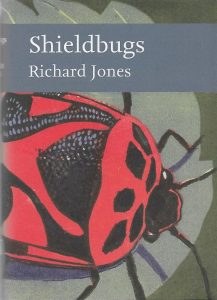Shieldbugs by Richard Jones. No. 147 in the New Naturalist Series.ISBN 978-0-00-833489-5 9-780008334895. 452pp. RRP £65.
The author has written a previous New Naturalist Series (NNS) book on Beetles (No.136, 2018), and Shieldbugs is presented with the same vigour and analysis that this expert entomologist gives his books. Covid gave him the opportunity to delve deeply into this group of small and sometimes colourful insects – producing a lockdown special – a very discursive one at that. The author admits to ‘verbose fact boxes and obsessive footnotes’ which I like, the more annotations the better.
The NNS books are mostly British-centric, but authors are always tempted to reference species from overseas particularly when the group they are talking about is biodiverse. Such is the case with this title. The author says that the book is ‘mainly about shieldbugs of the British Isles’, but that he occasionally makes references to exotic species including, for instance, edible species in Africa. He allowed himself this diversion in his other NNS book https://wildlifematters.com/?m=201803.
Jones introduces us to the 79 species of British shieldbugs, the 11 species in the Channel Islands and 16 other species which are potential colonists to these islands. He admits to shieldbug distribution ‘skewed to the southeast’ which makes it a little unfair on entomologists north of the Thames. Climate change has affected the range of shieldbugs just like most insects, in this case incursions such as the Southern Green Shieldbug (arrived 2003). He presents data on even the latest shieldbug to the British list, the Trapezium Shieldbug discovered in East Sussex in 2019.
Slightly less than half the book is text, the remainder a key and descriptions of species illustrated with lots of colour photographs. Most of the shieldbugs are small, brown or black, some with white spots, resulting in identification difficulties – many cleared-up here. There are a number with striking red and black colour and this stands out in the book as if the author likes these shieldbugs particularly (I don’t blame him) and the greatest exemplar is The Firebug is expertly illustrated on the cover. His daughter drew the line drawings in the identification key.
Shieldbugs This is a book that is essential to be on the bookshelf of all those who collect NNS and entomologists in general. It is far too heavy for use in the field, only for reference and verification after fieldwork, for which it is now a definitive key work. This book thus fills the yawning gap since Southwood and Leston’s 1959 book on Land and Water Bugs. Today there is also a 35pp ‘Provisional atlas of shieldbugs and allies’ (2018) by Tristan Bantock (for the Terrestrial Heteroptera Recording Scheme) which can be downloaded to a mobile phone for use in the field.
The book is written with a sense of humour and a great deal of passion which shines through – giving this generally drab group colour. Without all this being ‘flippant nonsense’ he writes (and says don’t write in), he has actually designated collective nouns for 16 species that have the tendency to live together in groups – perhaps an attempt to dissuade predators. Two that come to mind, the glamorous firebug is an ‘Inferno of Firebugs’ and the Common dock bug, is a ‘Coven of Dock Bugs’. This is hardly flippant stuff, it is useful that someone has given some time to describe what is going in the hitherto world of unreported bugs. So it all adds up to the increased knowledge on this group that this NNS addresses.
The colour photography has been sourced principally from Shutterstock and Wikimedia and the author’s colleagues – small shieldbugs are not too easy to shoot, at least to get some reasonable shots showing identification features, but this has been overcome. The production of the book is up to the usual high standards of the NNS with indexes and references.
